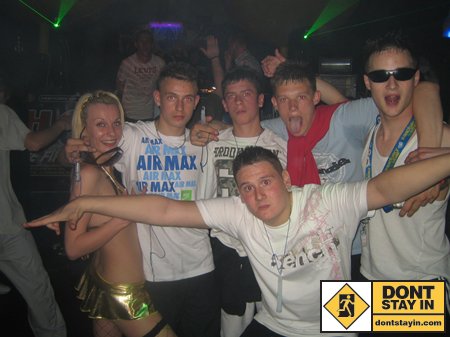In a world where experimental electronic music exponentially splinters into a multitude of rogue genres that slowly shuffle the globe from demilitarized dance floors to sleeper cell bedroom studios and back, a team of disparate scientists tracks this solanum-like pandemic while desperately trying to interpret cryptic field recordings of Samhain’s past, not one day at a time, but from Amen to Zombie…
AMEN

What’s this look like to you? What country? What year? What style of music is blaring in the background? How old are these kids? Is that girl wearing any panties? No, the one with the Air Max shirt on.
Questions, questions, questions. This week we start off the Cs in the Juno back catalog with 20 records by Cabbie. So my first question is: why is this entire page of releases dedicated to just one artist? In all the AMEN entries up until this point that has never happened. Questions of the prolific nature of this artist named Cabbie, his popularity in general, and others start splintering off as well. But a more pressing question comes to the fore:
Why does Jump-Up suck?
Before we dig into this question, let’s define our terms and reiterate that this blog is opinion. You may feel offended by the above question, but I hope to show you that, should you choose to dig on Jump-Up, you’re enjoying an inferior product. Everyone is guilty of this though; it’s what makes art so fun to consume, produce, and talk about. Everyone can produce a line of logic about why they like something. Sometimes this line is only two points: you and the thing e.g. “I like it just because I like it.” And this can again be lumped into two very general camps. “This speaks to me in such a specific way that it no longer has any reference to its original form, and so I like it because I like it and it’s the way I feel that I like.” versus “I don’t care that this is cheesy or that it’s pop, or that it’s very clear that the intent of this thing is to appeal to as wide a range of people as possible, to the point of making it soulless and an empty shell for advertising to stick their names on, I like it because I like it.” The first one would be something like GEM cream soda (The drink of taste!), the second would be Coke. Now I enjoy both, got somewhat of a Coke addiction in fact (nothing better than Coke and grenadine) but I think everyone recognizes that as a soft drink, Coke is not the best thing for you. Something that uses cane sugar and natural flavoring is better for you health wise. And a company that puts advertising where it belongs (in super markets, on TV, etc.) is better than plastering cities and country sides alike with advertising that you can see a half a mile away, and therefore can’t get away from. But then again that’s just me, which leads us back to the fact that this blog is my opinion that I’m trying to support with logic and examples.
A good example of Jump-Up would be Pink Socks. The above link should give you some info on the nuts and bolts of a Jump-Up tune, but the basics are: repetition and LFO baselines. Repetition meaning that an 8 bar loop (a break) is shuffled to compose a “song.” Maybe dropping the b-line or a quick buildup of rolling snares is about the extent of composition that you’re going to get in a Jump-Up tune. A quick run down of the b-line is take a 3 tone, 8 bar sine wave and throw an envelope filter on it. Lots of tunes employ call and response as well. This design serves two purposes I think, one is to be easy to mix. All the tunes have this template so that you can very easily manipulate anything labeled “Jump-Up” when mixing records. Two would be that it puts the DJ in more of the driver’s seat. DJ’s love beatmatching records, to the point where some people think that being a DJ is all about finding a “sound” or record label, collecting those records that sound similar, then mix them together in (un)creative ways.
This is where I find that Jump-Up falls down. If your source material all sounds similar, you are going to essentially be making “minimal” music when you mix it as a DJ or you try to build a Jump-Up track, meaning music that is mainly concerned with simple changes. It’s unfortunate that “Minimal” means techno most of the time, but that’s minimal with a capital M. In my sense “minimal” could also stand in for “lazy” or “minimal effort.” The dropping the b-line or whatever tends to get abused by both DJs and producers of Jump-Up. What you also get is a DJ set that has no signs of slowing down. If you were to look at it visually it would look like a hot dog. Every tune has an intro, so by default a DJ is going to have to play that to introduce their sound and prepare people for what’s about to come next. Then it’s just mix the shit out of some tracks (about 34) for an hour. Let the last record play out and the next DJ can come on. It’s just fast mixing, slamming down tunes as fast as you can. They all have similar sounds, so there’s really no reason to let a tune play for more than two minutes, which again gives the DJ more power, or I should say it makes his presence more know by constantly introducing a new tune to the audience. But at the same time, it consolidates the DJ’s job to just beatmatching a bunch of tunes that are already designed to sound similar. You might be saying, “That’s still an important part of DJing, you can’t play House then Breakcore for a bunch of people who want to just dance and drink.” Good point, and yes DJs should be conscious of genre, but not at the expense of programming or the flow of a DJ set. Even people rolling on 3 E’s and Grey Goose need a break. And good DJs don’t wear all your dancers out or the next DJ might suffer from a 20 minute bathroom break at the beginning of her set because a Jump-Up DJ wore everyone out with a solid 50 minutes of energy. DJs should lead, but also be courteous to those on the dance, as well as other DJs.
And on the production side of Jump-Up I think I have an answer to the question of why an entire page of Juno’s back catalog is dedicated to one producer. There seems to be some cool cache with certain producers and genres with how quick you can crank out a tune. I was listening to Skream do a lecture at the Red Bull Music academy, and he seemed to be bragging that he had made something like 5000 tunes and only takes 5 minutes to complete a tune. That’s a little obtuse, but it’s not far from what he actually said. I really can’t understand why it’s that cool to crank out a tune that fast. Basically what you’re going to have time to do is quickly get together a 16-bar loop and then shuffle its parts. That’s about it. And then you call that a tune. What it really is is a sketch. A very quick chunk of musical information that is being specifically designed to be mixed by a DJ. That being said, the obvious exception to the rule is that sometimes inspiration comes to you and you can very quickly put something together that will stand the test of a few months and people will still want to hear it. So there’s nothing wrong with working fast, unless that is the one thing you are trying to achieve. Working on something to work on something fast is a strange thing to wrap around your head. If the only reason you are doing something (building a track) is to get it done in the fastest time possible, then there is no reason for you to do it in the first place, because the fastest time possible is no time. But some people DO decide to make Jump-Up tunes in the quickest way possible, using the rhythms and structures as defined by the genre in the easiest way possible. This is why there’s 30+ tracks on a single page of the Juno back catalog by the same artist that all sound similar (and not similar because they are coming from the same producer, Cabbie, who is substituting a genre and a set of rules for his “sound”) This is what makes Jump-Up an inferior product. This is why Jump-Up sucks.
Whew! I need a GEM cream soda, let’s get back to our club kids.

You might be asking “Who’s this douche?” But hold on, you lady pants wearing motherfucker, this guy deserves to be heard just as much as you. The two photos in this post are from Don’t Stay In.com. Specifically they’re a bunch of people having fun at a Jump-Up gig. Don’t Stay In is 100 times more vapid than Myspace and is a place for club kids to put up photos of themselves, share info about gigs on a more global level, and chat about how “Fat gurls should get their bellybuttons pierced.” Harmless really. I’ll grant you that it’s a bit annoying, but really, harmless. As is my critique of Jump-Up. But, just look at the kids. Who doesn’t want to kick it with their best friends and chat to the opposite sex? Or the same, whatever. I’m showing these photos for a couple of reasons. Partly to have a little laugh at club kids. Can anyone else tell that the first picture is from the UK and the second is from the US? But mostly to put a face to the Jump-Up sound. These kids are having a blast listening to what I consider inferior music. The incorrect assumption is to say that they’re idiots for going to a Jump-Up gig, because Jump-Up sucks. For obvious reasons, right? Not everyone is there for the music, and as long as it’s got some repetitiveness in the 110-160 BPM range everyone can get down and have fun. However they’re not innocent either. I think they suffer from the same laziness that Jump-Up producers suffer from. But, here’s where you’re allowed to get a little high and mighty I think. These kids just wanna get down. Who makes the decisions on the dance? The DJ. Where does a DJ get his cues? Producers.
Which brings us to: Why not drink JEM cream soda instead of Coke? Why do DJs choose crap to feed their dancers? I honestly don’t know, but I’ll bet donuts to dollars that it’s a bunch of answers instead of something simple like “some DJs are stupid and don’t want to try anything new.” If I had to guess it would be that more complex music has the stigma of being for serious listening. Which blows my mind. Even as simple as Jump-Up is, it still has syncopation and, lest we forget, is still a sub-genre of d&b. Which is pretty advanced when you look at Trance, which also sucks. As a genre that is. Of course there are some classic Jump-Up tunes. “Fugees or Not” is a classic and a good tune. Hell, I love the Art of Trance track “Panorama,” which will bring us to the struggle with music and genres not making complete sense in terms of the other. But let’s sidestep the “good music is good music” argument and get back to those kids on the dance.
How amazing would it be if the kids in the photos above could be seen brocking out to “Come on my Selecta” instead of some bullshit Cabbie tracks? Oh yeah, there was nothing on the first page of C in the Juno back catalog that was worth recommending. There’s so much more to be offered by not only d&b, but other Jump-Up producers. Don’t bother with Cabbie. But how easy would it be to slip in some truly next-level bass music to a group of clubbers without getting some chin strokers? Can you imagine people drinking PBRs and inventing new dance moves to something like “In C” or “Music for Airports?” On a Tuesday? And that being the “normal” thing to do? Why not? It can’t all be Beer & Pussy.
So it goes.








Social Media